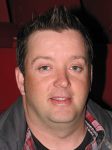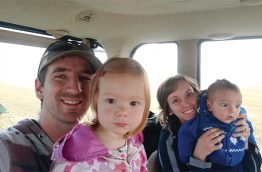Building leaders
 Lee and Jenaya Crosson
Lee and Jenaya Crosson
Welwyn, Sask.
“Being involved is time consuming, and I had the impression it was something you did when you’re my dad’s age. At that age, your experiences can be a help to the industry, but by waiting that long, you probably miss out on the benefits this knowledge brings to yourself.”
Lee and Jenaya Crosson are a young farming couple who, along with Lee’s brother, are slowly taking over the Crosson family farm. Succession planning is in full swing, which was one topic that attracted them to SaskCanola’s two-day leadership conference in 2016.
“One thing I learned at the conference is to ask what family and staff in the operation like to do,” Jenaya says. Rather than focus on what has to be done and what people are currently doing, find out if certain people prefer field work, livestock, agronomy, marketing or maintenance, for example. Then give them responsibilities in those areas. “Everyone gives and takes a little, but this can help get things started on the right foot.”
Lee liked the advice on getting involved in committees and boards earlier in a farming career. “By being involved, you get outside perspective to see what others are doing,” he says.
“Being involved is time consuming, and I had the impression it was something you did when you’re my dad’s age. At that age, your experiences can be a help to the industry,” Lee says, “but by waiting that long, you probably miss out on the benefits this knowledge brings to yourself.”
Lee and Jenaya haven’t joined any boards yet, but they probably will sooner rather than later. When the writer interviewed them in early January for this article, they were on their way to Saskatchewan Young Ag-Entrepreneurs Conference in Saskatoon.
 Brooks White
Brooks White
Pierson, Man.
Brooks White runs Borderland Agriculture, a bison ranch and grain farm, with his wife Jen and his father. He’s also involved in three off-farm boards: Manitoba Bison Association, Westman Agricultural Diversification Organization and Northern Prairies Ag Innovation Alliance (formerly Manitoba North Dakota Zero Till Farmers Association).
He’s currently a director on these boards, “but I see the day coming when I represent these organizations with leadership roles.” Which is why he accepted the invite to attend Manitoba Canola Growers Association’s leadership conference.
The agenda touched on organizational governance, which he feels could be enhanced in some of the boards he’s involved with.
He was also “taken out of his comfort zone” by having to make a pitch to a journalist with a hot topic that was important to him and that he felt needed some exposure. “My pitch for this was regarding promoting a website to collect donations for a project educating the importance of farm safety.”
In one session, conference attendees had to think about where they wanted to be in 20 years. From that end goal, White had to “backcast” every step along the way, creating a timeline of steps to get to that end goal. “We used that exercise to provide direction to the farm and to complete a proper business plan that we can use to try growing our business,” he says.
White did a similar exercise with Canadian Total Excellence in Agricultural Management (CTEAM), a farm management course. The course offers a balance of financial management along with succession and human resources training. “Through this program, I have also seen a lot of value from the networking with 20 other farmers from across Canada who are involved in many different aspects of agriculture.”
Growing his network has been a big side benefit from the leadership conference and CTEAM. “After networking with other like-minded farmers, I leave energized and with new ideas to try.”
 Cale Staden
Cale Staden
Vermilion, Alta.
“The great thing about my position is that my grandpa, dad and uncle have always been open to trying new ideas and using new technology. This is important because doing what everyone else does or sticking with what we’ve done in the past personally doesn’t engage me.”
Cale Staden, brand new director of Alberta Canola, is also in a community of young like-minded farmers who attended Alberta Canola’s Leaders Conference. “We stay engaged with each other through a Facebook group where we can ask each other about farm business,” he says. “It helps that many of us are going through the same challenges.”
Staden came back to the family farm two years ago after a stint in the corporate world. He and his family run a mixed farm with cattle, bison and grains. “The great thing about my position is that my grandpa, dad and uncle have always been open to trying new ideas and using new technology,” he says.
“This is important because doing what everyone else does or sticking with what we’ve done in the past personally doesn’t engage me.”
For this reason, he really liked Bob Treadway’s message at the conference. “Anyone who has sat across the table from Warren Buffet has my attention,” Staden says of Treadway, a futurist and strategy advisor.
Treadway encouraged young leaders to plan for the future and be proactive instead of reactionary. He told about Oscar Koch, brigadier general in the U.S. Army, who worked with General George Patton during WWII. Koch noticed the Germans stockpiling equipment and men in one particular location but thought it may have been a ploy to bait the Allies into focusing on the wrong flank. He advised Patton to consider other possibilities. Patton took the advice and devised a contingency plan — and was ready when the Germans attacked.
Staden compared that to Walter Gretzky’s now-famous advice to his son Wayne: “Skate to where the puck is going, not where it has been.”
Staden tries to be proactive on his farm when deciding which types of canola to grow (they have been growing specialty oils) and how to choose crops that build upon the livestock side of the business.
“Wheat prices aren’t that hot, so what should we do? We could put more acres into hayland for a few years, providing feed for the animals and a nice yield bounce for annual crops that follow.”
Through Facebook and other means, Staden wants to keep the contacts and the momentum of the Leaders Conference. “I don’t want it to end here. We should have a young farmers group, maybe even take it national.”
 Spencer Maxwell
Spencer Maxwell
Nipawin, Sask.
“A good leader is inner-reflecting and self aware, and part of getting to that point is to ask yourself questions you wouldn’t normally think about.”
Spencer Maxwell, who lives in Nipawin and farms with his dad north of Carrot River, just started making the decisions on his own fields. As for joining a board, “I have been nervous to stick my neck out and be more involved without having a lot of farming and boardroom experience,” he says. But at SaskCanola’s leadership conference, former SaskCanola director Stan Jeeves inspired him, saying: “When you believe in your own opinions and are ready for them to be heard, then you’re ready to get involved.”
As Jeeves and others added, the best way to get experience is to get involved.
One message that came through for Maxwell was the importance of asking questions. Presenter Vern Bachiu said good board chairs lead by asking questions rather than trying to provide all the answers.
Questions broaden the discussion, get more people engaged, bring out more ideas and help the whole board understand more.
“I learned to ask questions all the time, whether around the farm, in business or on a board,” Maxwell says.
Presenter Rachelle Brockman got attendees to talk among themselves, and ask different questions to learn more about each other. Maxwell remembers one of her suggestions: While networking, instead of asking the common “What do you do?” ask “Why do you do what you do?”
This question might also inspire people to learn more about themselves. “To be a good leader you have to know yourself,” Maxwell says. “A good leader is inner-reflecting and self aware, and part of getting to that point is to ask yourself questions you wouldn’t normally think about.”
One question she had was: “What is your biggest fear?” Maxwell’s is that his dad would suddenly pass away. “I have a lot to learn from him yet.”
Brockman also reminded attendees that perfection isn’t possible. “She told us to embrace our flaws,” Maxwell says. “She called herself ‘flawesome’.”
 Ingrid Badry
Ingrid Badry
Heisler, Alta.
Ingrid Badry was inspired by Bob Treadway after hearing him at Alberta Canola’s Leaders Conference.
Treadway encouraged his audience to set what seem like unreachable goals and then use “back-casting” to map out a way to achieve them. He compared it to NASA putting a man on the moon.
Instead of listening to those who said it was impossible, the space administration set the “unreachable” goal and then worked back through all the steps that would be needed to reach it.
One way the Badrys could use this technique is for yard planning. The Badrys have a vision for their yard, but when seen as one big task it is too daunting to begin. They plan to set a 10-year goal and then work backwards to determine steps for year eight, year six, and so on. This year, as step one, the Badrys moved a few bins to accommodate the increasing size of equipment. “Once you have your goal, you can come up with the second-last step and the third-last step,” she says. “But the first step is often the hardest to figure out.”

She says back-casting can also help solve bigger issues such as sustainability and soil health that are buzzing around the ag community. The worry for farmers, she says, is how to make big changes without sacrificing income. “We’re so used to farming the way we know how,” she says. “Back-casting will be a useful tool to improving the way we farm.”
The idea that we can set goals to address major challenges is “a positive powerful attitude,” she says.






